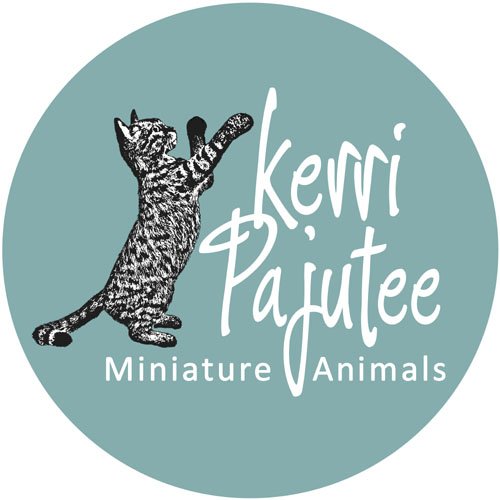About the Process
Kerri Pajutee's miniature animal sculptures begin by sketching a 1:12 scale template of the subject combined with reference drawings and/or real-life photographs. Depending on the size and pose of the sculpture, it may be necessary to construct an armature for support. To replicate larger animals, armature is fashioned from copper wire and aluminum foil wrapped in masking tape. For smaller sculptures, such as a 1:12 scale cat, the armature consists of fine gauge wire that is delicately inserted into the legs, neck and tail.
Kerri hand-builds her sculptures with polymer clay and employs both addition and subtraction techniques. Once the basic shape has been formed, it is placed into the oven to bake for approximately 9 minutes. This will partially cure the clay sculpture to a leather-hard consistency. After cooling, details are carved and refined into the baked clay using micro tools (i.e., scalpels, burrs, or carbide scrapers). The eyes consist of handcrafted UV resin or onyx beads which are inset securely into hollowed-out sockets. The surface of the sculpture is smoothed using a fine-grit sandpaper and/or a paintbrush dipped in 99% isopropyl alcohol. When surface details are accomplished, the sculpture is once again placed into the oven to finalize curing of the clay.
After curing, the sculpture is bathed in warm soapy water to remove any residue. The sculpture’s basic coat color(s)will be detailed in heat-set paints or acrylics, as well as highlighting the eyelids, nose leather, lips, paw pads, etc. Once painting is complete, the sculpture is permanently ‘dressed’ in a lifelike coat of applied natural fibers. Some of Kerri’s favorite fibers include alpaca, wool, cashmere, mohair, cotton or silk.
The texture and length of coat will determine the type of fiber used. To replicate medium to long-haired coats, small chunks of fiber are methodically applied to the sculpt (layer by overlapping layer) with tweezers and glue. For short coats, a 'flock' (fiber that has been cut to a powder-fine consistency) is gently pressed onto the wet glue surface using a fingertip or sponge tool. When replicating birds, an addition of cut-to-size feathers are combined with flock made from fine wool, silk or cotton thread.
Once the fiber coat has been applied and the glue thoroughly dried, some additional hand-combing, trimming and shaping may be required using razor-sharp scissors. Details such as spots, stripes or rosette patterns are added to the coat’s surface utilizing professional heat-set artist inks. Lastly, the fiber coat is carefully spray-sealed with a fine mist of non-yellowing artist fixative to set the fiber and minimize shedding.
The entire process from inspiration to final scissor clip is tedious, exacting, and requires numerous hours to complete, but, the time investment is well worth the effort.



